Report on Characteristics of Successful Merger and Acquisitions
VerifiedAdded on 2021/11/21
|23
|7922
|87
Report
AI Summary
This report provides a critical evaluation of the characteristics of successful mergers and acquisitions (M&A). It begins with an introduction to M&A, highlighting its importance in the context of increasing competition and globalization, and emphasizes the strategic use of M&A for international expansion and growth. The report then delves into the concept of M&A, differentiating between mergers and acquisitions, and explores horizontal and vertical mergers. The report also discusses the objectives of M&A, such as achieving economies of scale, maximizing shareholder value, and creating synergies. The core of the report focuses on the characteristics of successful M&A, including portfolio diversification and internal control. It uses examples like Dell Inc.'s diversification strategy and the role of agency theory in aligning managerial interests to illustrate these characteristics. The report concludes by highlighting the importance of these characteristics in achieving the growth and expansion objectives of businesses.
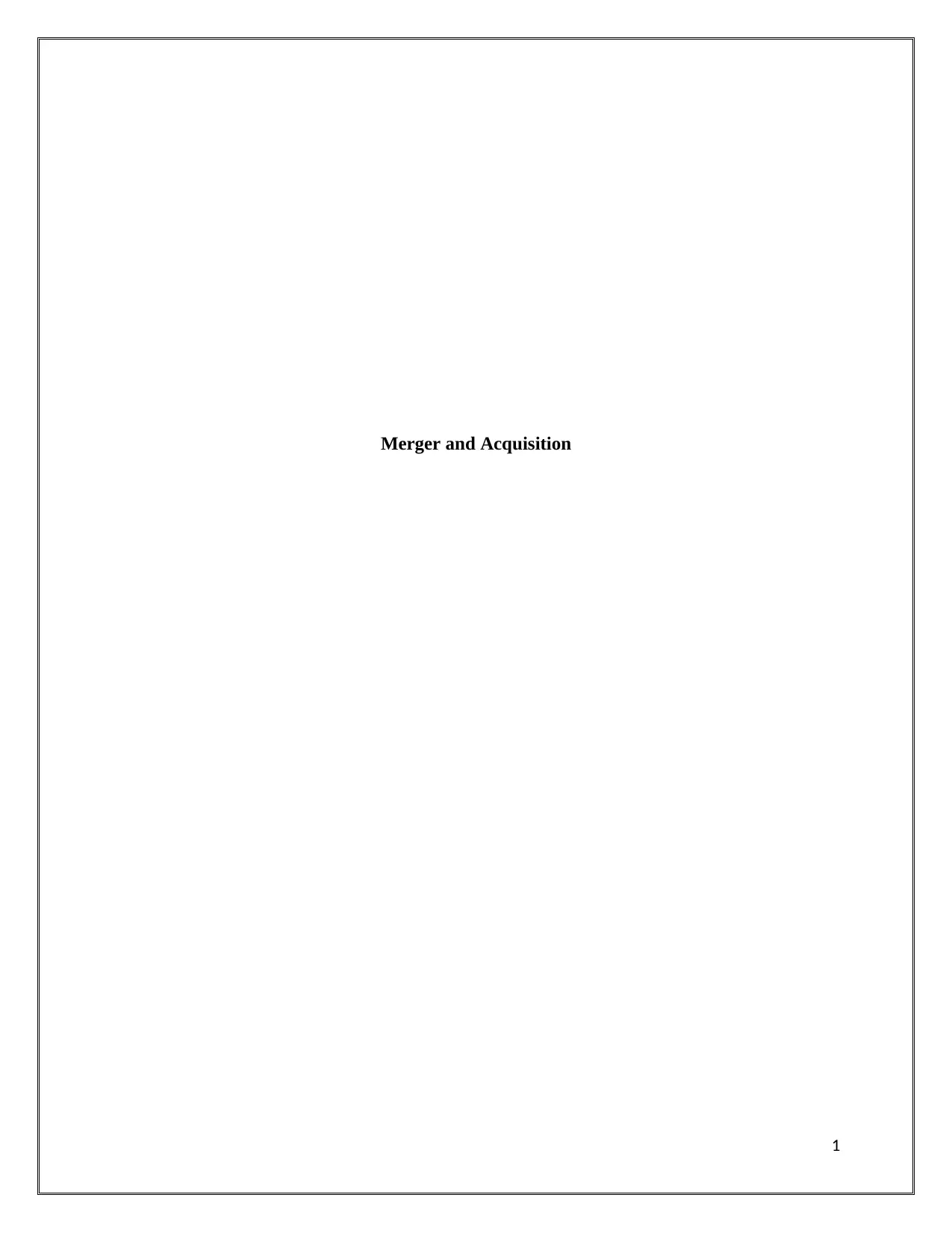
Merger and Acquisition
1
1
Paraphrase This Document
Need a fresh take? Get an instant paraphrase of this document with our AI Paraphraser
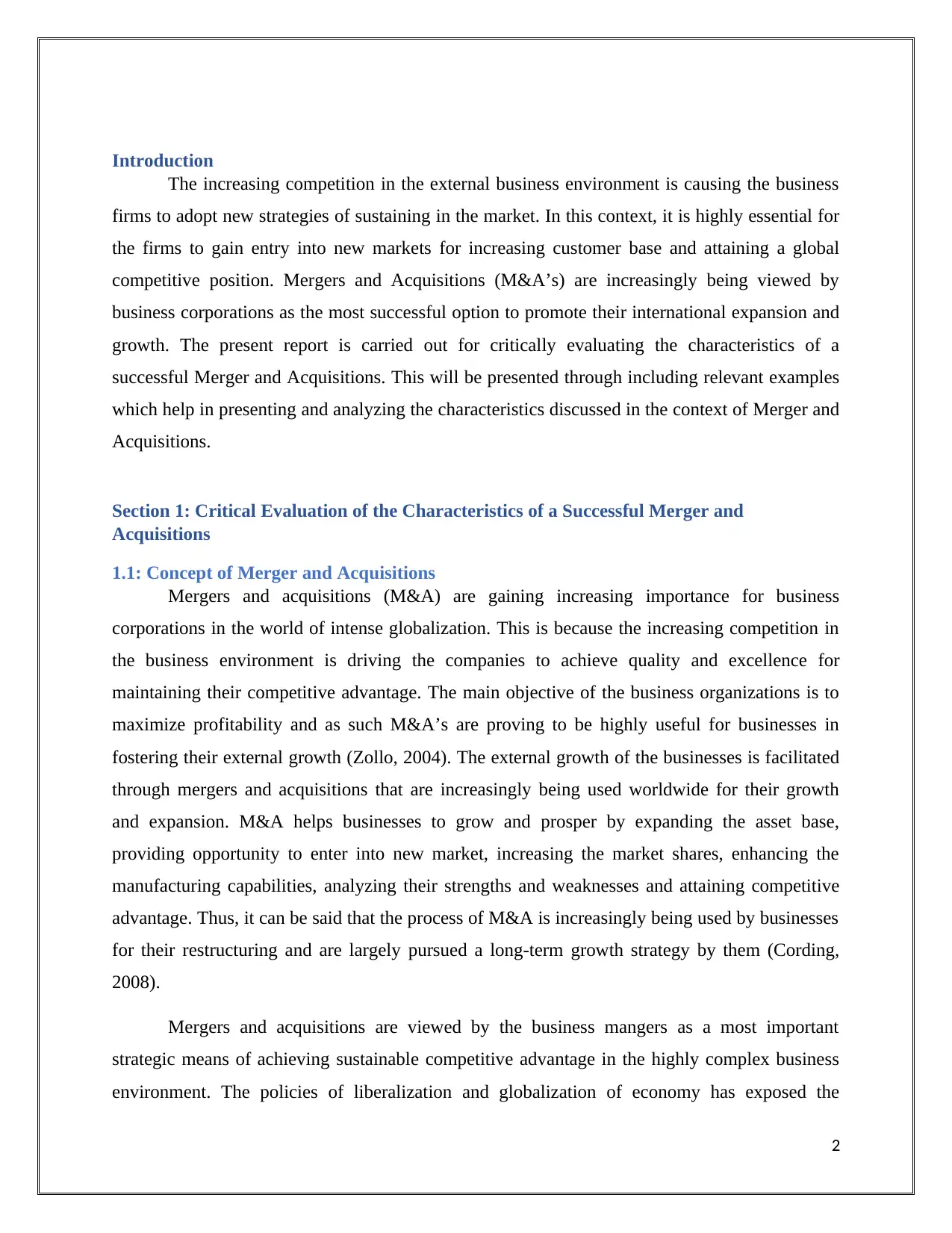
Introduction
The increasing competition in the external business environment is causing the business
firms to adopt new strategies of sustaining in the market. In this context, it is highly essential for
the firms to gain entry into new markets for increasing customer base and attaining a global
competitive position. Mergers and Acquisitions (M&A’s) are increasingly being viewed by
business corporations as the most successful option to promote their international expansion and
growth. The present report is carried out for critically evaluating the characteristics of a
successful Merger and Acquisitions. This will be presented through including relevant examples
which help in presenting and analyzing the characteristics discussed in the context of Merger and
Acquisitions.
Section 1: Critical Evaluation of the Characteristics of a Successful Merger and
Acquisitions
1.1: Concept of Merger and Acquisitions
Mergers and acquisitions (M&A) are gaining increasing importance for business
corporations in the world of intense globalization. This is because the increasing competition in
the business environment is driving the companies to achieve quality and excellence for
maintaining their competitive advantage. The main objective of the business organizations is to
maximize profitability and as such M&A’s are proving to be highly useful for businesses in
fostering their external growth (Zollo, 2004). The external growth of the businesses is facilitated
through mergers and acquisitions that are increasingly being used worldwide for their growth
and expansion. M&A helps businesses to grow and prosper by expanding the asset base,
providing opportunity to enter into new market, increasing the market shares, enhancing the
manufacturing capabilities, analyzing their strengths and weaknesses and attaining competitive
advantage. Thus, it can be said that the process of M&A is increasingly being used by businesses
for their restructuring and are largely pursued a long-term growth strategy by them (Cording,
2008).
Mergers and acquisitions are viewed by the business mangers as a most important
strategic means of achieving sustainable competitive advantage in the highly complex business
environment. The policies of liberalization and globalization of economy has exposed the
2
The increasing competition in the external business environment is causing the business
firms to adopt new strategies of sustaining in the market. In this context, it is highly essential for
the firms to gain entry into new markets for increasing customer base and attaining a global
competitive position. Mergers and Acquisitions (M&A’s) are increasingly being viewed by
business corporations as the most successful option to promote their international expansion and
growth. The present report is carried out for critically evaluating the characteristics of a
successful Merger and Acquisitions. This will be presented through including relevant examples
which help in presenting and analyzing the characteristics discussed in the context of Merger and
Acquisitions.
Section 1: Critical Evaluation of the Characteristics of a Successful Merger and
Acquisitions
1.1: Concept of Merger and Acquisitions
Mergers and acquisitions (M&A) are gaining increasing importance for business
corporations in the world of intense globalization. This is because the increasing competition in
the business environment is driving the companies to achieve quality and excellence for
maintaining their competitive advantage. The main objective of the business organizations is to
maximize profitability and as such M&A’s are proving to be highly useful for businesses in
fostering their external growth (Zollo, 2004). The external growth of the businesses is facilitated
through mergers and acquisitions that are increasingly being used worldwide for their growth
and expansion. M&A helps businesses to grow and prosper by expanding the asset base,
providing opportunity to enter into new market, increasing the market shares, enhancing the
manufacturing capabilities, analyzing their strengths and weaknesses and attaining competitive
advantage. Thus, it can be said that the process of M&A is increasingly being used by businesses
for their restructuring and are largely pursued a long-term growth strategy by them (Cording,
2008).
Mergers and acquisitions are viewed by the business mangers as a most important
strategic means of achieving sustainable competitive advantage in the highly complex business
environment. The policies of liberalization and globalization of economy has exposed the
2
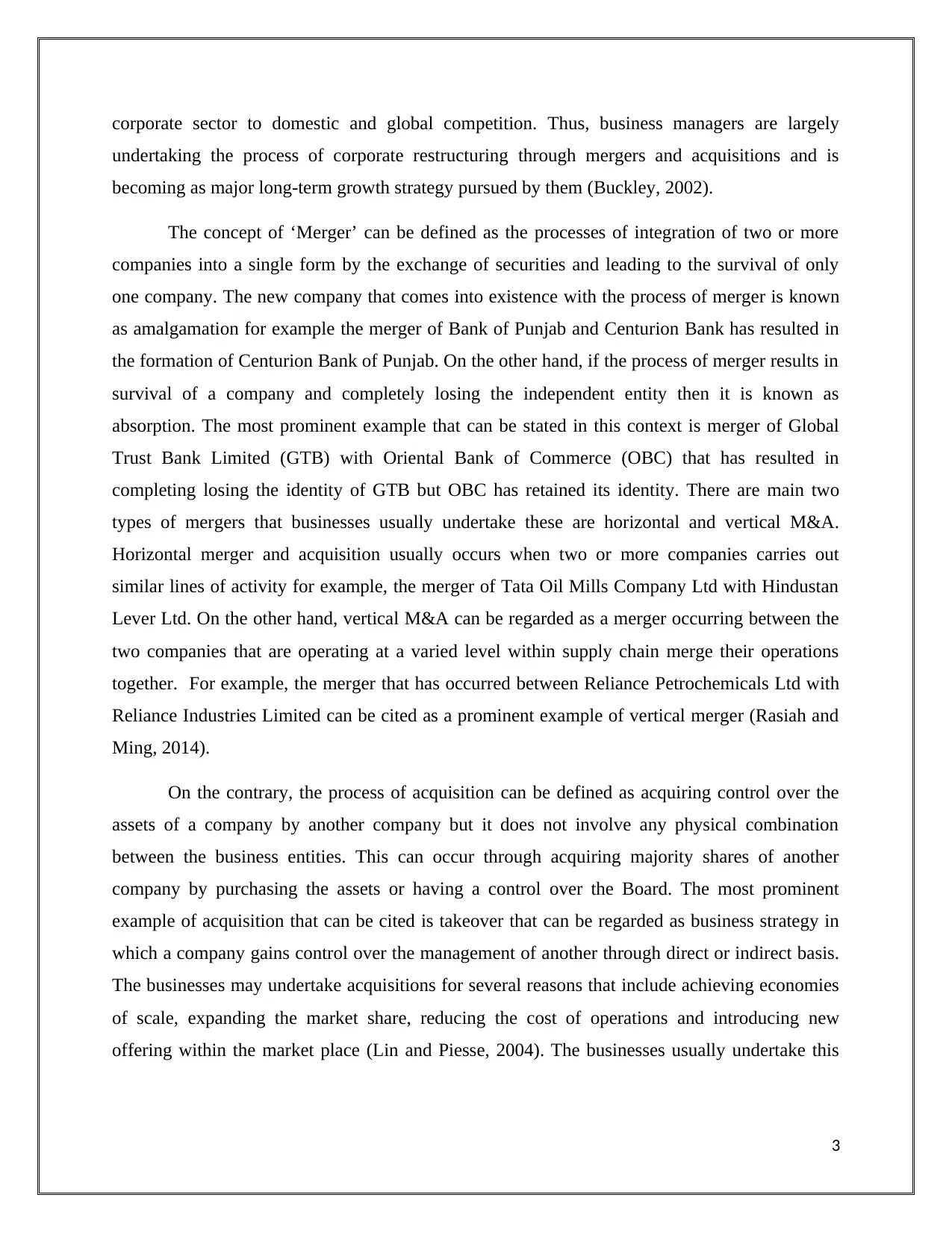
corporate sector to domestic and global competition. Thus, business managers are largely
undertaking the process of corporate restructuring through mergers and acquisitions and is
becoming as major long-term growth strategy pursued by them (Buckley, 2002).
The concept of ‘Merger’ can be defined as the processes of integration of two or more
companies into a single form by the exchange of securities and leading to the survival of only
one company. The new company that comes into existence with the process of merger is known
as amalgamation for example the merger of Bank of Punjab and Centurion Bank has resulted in
the formation of Centurion Bank of Punjab. On the other hand, if the process of merger results in
survival of a company and completely losing the independent entity then it is known as
absorption. The most prominent example that can be stated in this context is merger of Global
Trust Bank Limited (GTB) with Oriental Bank of Commerce (OBC) that has resulted in
completing losing the identity of GTB but OBC has retained its identity. There are main two
types of mergers that businesses usually undertake these are horizontal and vertical M&A.
Horizontal merger and acquisition usually occurs when two or more companies carries out
similar lines of activity for example, the merger of Tata Oil Mills Company Ltd with Hindustan
Lever Ltd. On the other hand, vertical M&A can be regarded as a merger occurring between the
two companies that are operating at a varied level within supply chain merge their operations
together. For example, the merger that has occurred between Reliance Petrochemicals Ltd with
Reliance Industries Limited can be cited as a prominent example of vertical merger (Rasiah and
Ming, 2014).
On the contrary, the process of acquisition can be defined as acquiring control over the
assets of a company by another company but it does not involve any physical combination
between the business entities. This can occur through acquiring majority shares of another
company by purchasing the assets or having a control over the Board. The most prominent
example of acquisition that can be cited is takeover that can be regarded as business strategy in
which a company gains control over the management of another through direct or indirect basis.
The businesses may undertake acquisitions for several reasons that include achieving economies
of scale, expanding the market share, reducing the cost of operations and introducing new
offering within the market place (Lin and Piesse, 2004). The businesses usually undertake this
3
undertaking the process of corporate restructuring through mergers and acquisitions and is
becoming as major long-term growth strategy pursued by them (Buckley, 2002).
The concept of ‘Merger’ can be defined as the processes of integration of two or more
companies into a single form by the exchange of securities and leading to the survival of only
one company. The new company that comes into existence with the process of merger is known
as amalgamation for example the merger of Bank of Punjab and Centurion Bank has resulted in
the formation of Centurion Bank of Punjab. On the other hand, if the process of merger results in
survival of a company and completely losing the independent entity then it is known as
absorption. The most prominent example that can be stated in this context is merger of Global
Trust Bank Limited (GTB) with Oriental Bank of Commerce (OBC) that has resulted in
completing losing the identity of GTB but OBC has retained its identity. There are main two
types of mergers that businesses usually undertake these are horizontal and vertical M&A.
Horizontal merger and acquisition usually occurs when two or more companies carries out
similar lines of activity for example, the merger of Tata Oil Mills Company Ltd with Hindustan
Lever Ltd. On the other hand, vertical M&A can be regarded as a merger occurring between the
two companies that are operating at a varied level within supply chain merge their operations
together. For example, the merger that has occurred between Reliance Petrochemicals Ltd with
Reliance Industries Limited can be cited as a prominent example of vertical merger (Rasiah and
Ming, 2014).
On the contrary, the process of acquisition can be defined as acquiring control over the
assets of a company by another company but it does not involve any physical combination
between the business entities. This can occur through acquiring majority shares of another
company by purchasing the assets or having a control over the Board. The most prominent
example of acquisition that can be cited is takeover that can be regarded as business strategy in
which a company gains control over the management of another through direct or indirect basis.
The businesses may undertake acquisitions for several reasons that include achieving economies
of scale, expanding the market share, reducing the cost of operations and introducing new
offering within the market place (Lin and Piesse, 2004). The businesses usually undertake this
3
⊘ This is a preview!⊘
Do you want full access?
Subscribe today to unlock all pages.

Trusted by 1+ million students worldwide
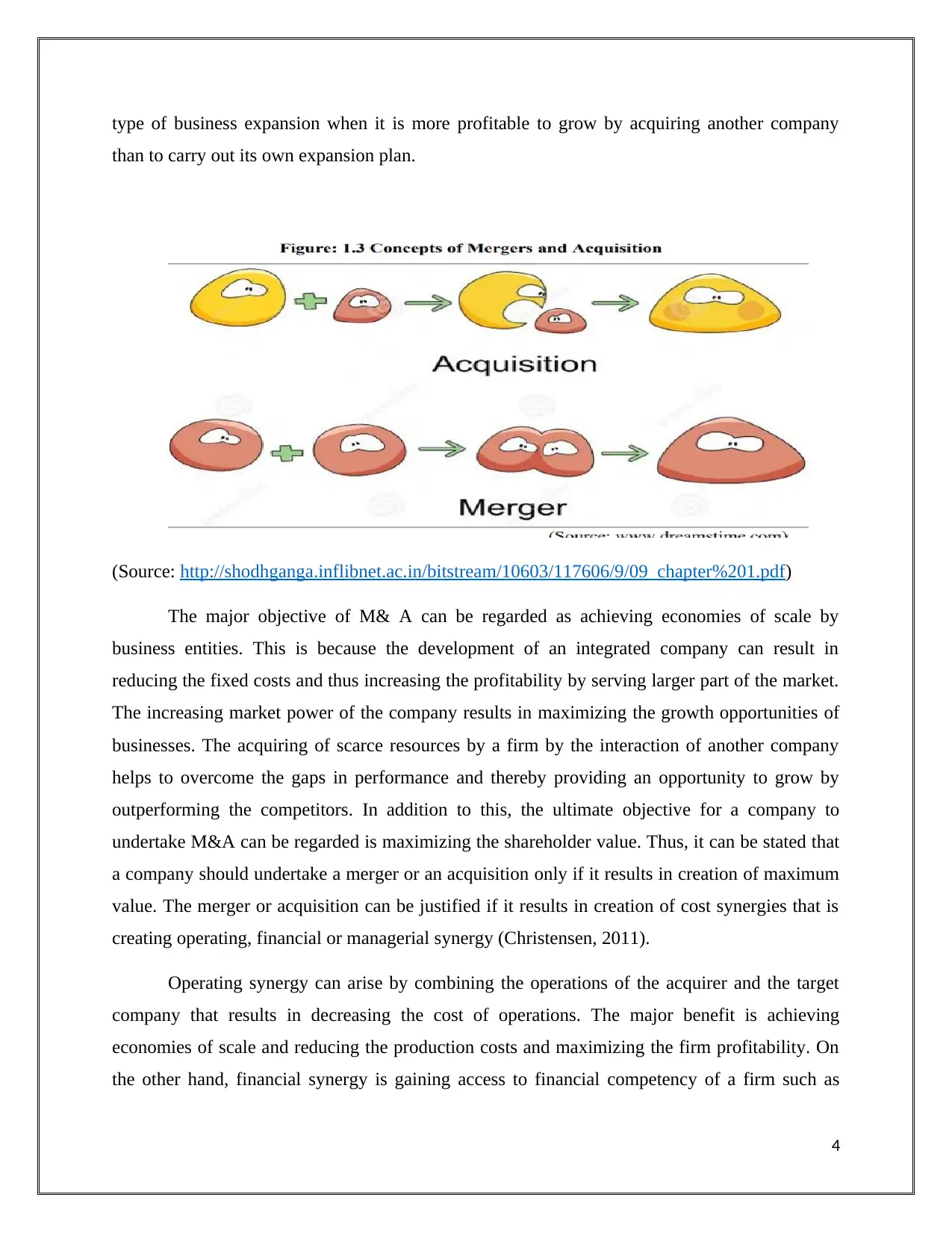
type of business expansion when it is more profitable to grow by acquiring another company
than to carry out its own expansion plan.
(Source: http://shodhganga.inflibnet.ac.in/bitstream/10603/117606/9/09_chapter%201.pdf)
The major objective of M& A can be regarded as achieving economies of scale by
business entities. This is because the development of an integrated company can result in
reducing the fixed costs and thus increasing the profitability by serving larger part of the market.
The increasing market power of the company results in maximizing the growth opportunities of
businesses. The acquiring of scarce resources by a firm by the interaction of another company
helps to overcome the gaps in performance and thereby providing an opportunity to grow by
outperforming the competitors. In addition to this, the ultimate objective for a company to
undertake M&A can be regarded is maximizing the shareholder value. Thus, it can be stated that
a company should undertake a merger or an acquisition only if it results in creation of maximum
value. The merger or acquisition can be justified if it results in creation of cost synergies that is
creating operating, financial or managerial synergy (Christensen, 2011).
Operating synergy can arise by combining the operations of the acquirer and the target
company that results in decreasing the cost of operations. The major benefit is achieving
economies of scale and reducing the production costs and maximizing the firm profitability. On
the other hand, financial synergy is gaining access to financial competency of a firm such as
4
than to carry out its own expansion plan.
(Source: http://shodhganga.inflibnet.ac.in/bitstream/10603/117606/9/09_chapter%201.pdf)
The major objective of M& A can be regarded as achieving economies of scale by
business entities. This is because the development of an integrated company can result in
reducing the fixed costs and thus increasing the profitability by serving larger part of the market.
The increasing market power of the company results in maximizing the growth opportunities of
businesses. The acquiring of scarce resources by a firm by the interaction of another company
helps to overcome the gaps in performance and thereby providing an opportunity to grow by
outperforming the competitors. In addition to this, the ultimate objective for a company to
undertake M&A can be regarded is maximizing the shareholder value. Thus, it can be stated that
a company should undertake a merger or an acquisition only if it results in creation of maximum
value. The merger or acquisition can be justified if it results in creation of cost synergies that is
creating operating, financial or managerial synergy (Christensen, 2011).
Operating synergy can arise by combining the operations of the acquirer and the target
company that results in decreasing the cost of operations. The major benefit is achieving
economies of scale and reducing the production costs and maximizing the firm profitability. On
the other hand, financial synergy is gaining access to financial competency of a firm such as
4
Paraphrase This Document
Need a fresh take? Get an instant paraphrase of this document with our AI Paraphraser
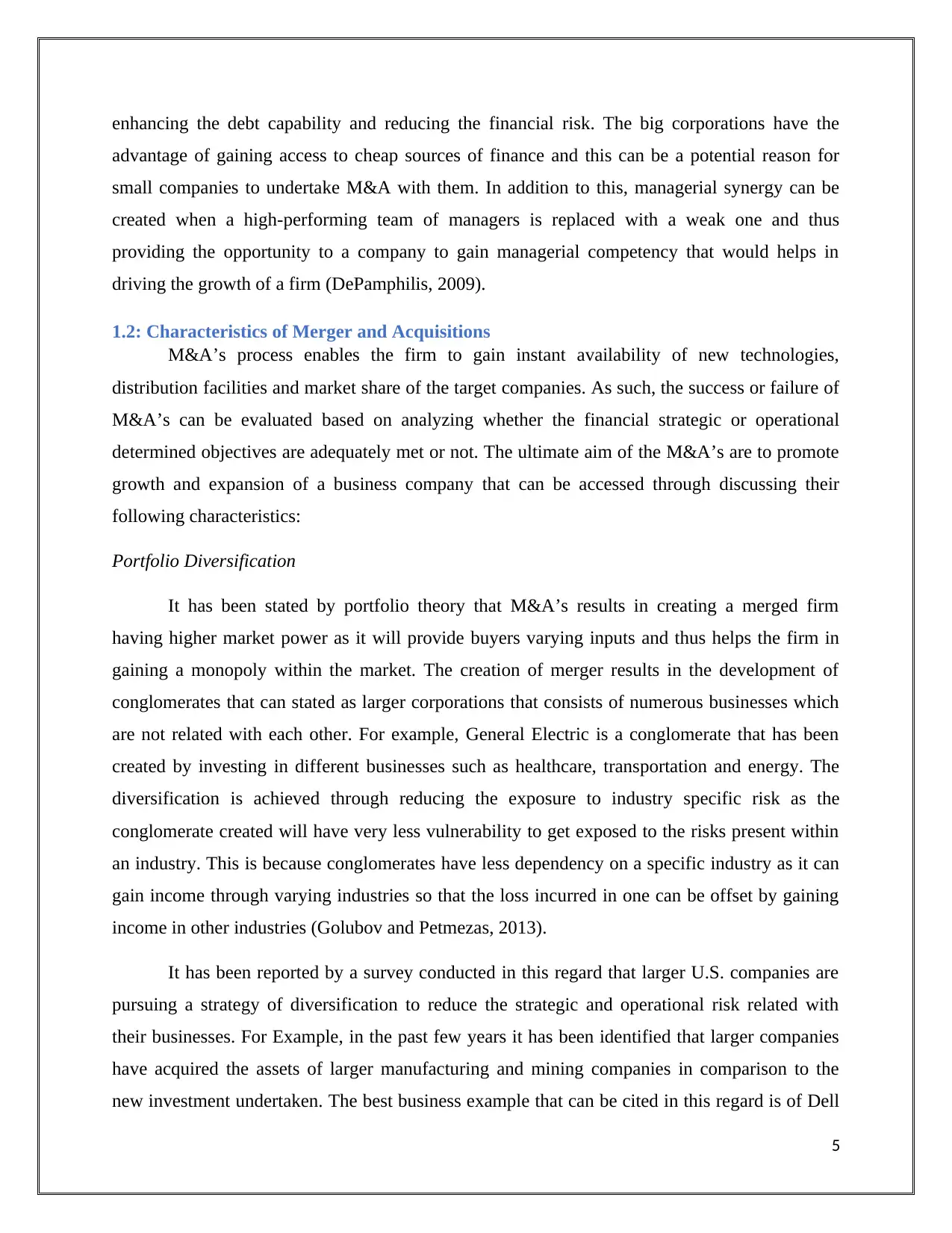
enhancing the debt capability and reducing the financial risk. The big corporations have the
advantage of gaining access to cheap sources of finance and this can be a potential reason for
small companies to undertake M&A with them. In addition to this, managerial synergy can be
created when a high-performing team of managers is replaced with a weak one and thus
providing the opportunity to a company to gain managerial competency that would helps in
driving the growth of a firm (DePamphilis, 2009).
1.2: Characteristics of Merger and Acquisitions
M&A’s process enables the firm to gain instant availability of new technologies,
distribution facilities and market share of the target companies. As such, the success or failure of
M&A’s can be evaluated based on analyzing whether the financial strategic or operational
determined objectives are adequately met or not. The ultimate aim of the M&A’s are to promote
growth and expansion of a business company that can be accessed through discussing their
following characteristics:
Portfolio Diversification
It has been stated by portfolio theory that M&A’s results in creating a merged firm
having higher market power as it will provide buyers varying inputs and thus helps the firm in
gaining a monopoly within the market. The creation of merger results in the development of
conglomerates that can stated as larger corporations that consists of numerous businesses which
are not related with each other. For example, General Electric is a conglomerate that has been
created by investing in different businesses such as healthcare, transportation and energy. The
diversification is achieved through reducing the exposure to industry specific risk as the
conglomerate created will have very less vulnerability to get exposed to the risks present within
an industry. This is because conglomerates have less dependency on a specific industry as it can
gain income through varying industries so that the loss incurred in one can be offset by gaining
income in other industries (Golubov and Petmezas, 2013).
It has been reported by a survey conducted in this regard that larger U.S. companies are
pursuing a strategy of diversification to reduce the strategic and operational risk related with
their businesses. For Example, in the past few years it has been identified that larger companies
have acquired the assets of larger manufacturing and mining companies in comparison to the
new investment undertaken. The best business example that can be cited in this regard is of Dell
5
advantage of gaining access to cheap sources of finance and this can be a potential reason for
small companies to undertake M&A with them. In addition to this, managerial synergy can be
created when a high-performing team of managers is replaced with a weak one and thus
providing the opportunity to a company to gain managerial competency that would helps in
driving the growth of a firm (DePamphilis, 2009).
1.2: Characteristics of Merger and Acquisitions
M&A’s process enables the firm to gain instant availability of new technologies,
distribution facilities and market share of the target companies. As such, the success or failure of
M&A’s can be evaluated based on analyzing whether the financial strategic or operational
determined objectives are adequately met or not. The ultimate aim of the M&A’s are to promote
growth and expansion of a business company that can be accessed through discussing their
following characteristics:
Portfolio Diversification
It has been stated by portfolio theory that M&A’s results in creating a merged firm
having higher market power as it will provide buyers varying inputs and thus helps the firm in
gaining a monopoly within the market. The creation of merger results in the development of
conglomerates that can stated as larger corporations that consists of numerous businesses which
are not related with each other. For example, General Electric is a conglomerate that has been
created by investing in different businesses such as healthcare, transportation and energy. The
diversification is achieved through reducing the exposure to industry specific risk as the
conglomerate created will have very less vulnerability to get exposed to the risks present within
an industry. This is because conglomerates have less dependency on a specific industry as it can
gain income through varying industries so that the loss incurred in one can be offset by gaining
income in other industries (Golubov and Petmezas, 2013).
It has been reported by a survey conducted in this regard that larger U.S. companies are
pursuing a strategy of diversification to reduce the strategic and operational risk related with
their businesses. For Example, in the past few years it has been identified that larger companies
have acquired the assets of larger manufacturing and mining companies in comparison to the
new investment undertaken. The best business example that can be cited in this regard is of Dell
5
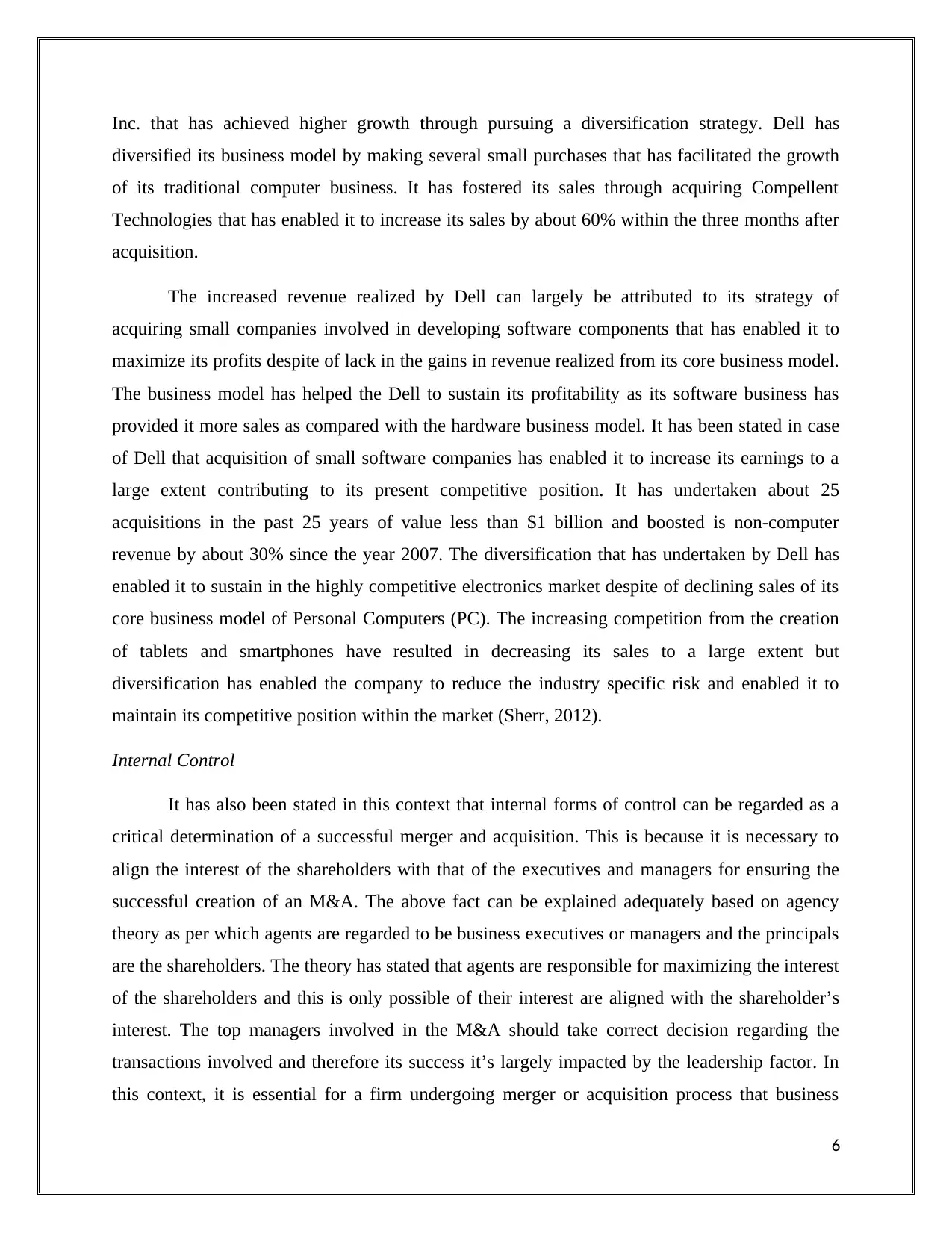
Inc. that has achieved higher growth through pursuing a diversification strategy. Dell has
diversified its business model by making several small purchases that has facilitated the growth
of its traditional computer business. It has fostered its sales through acquiring Compellent
Technologies that has enabled it to increase its sales by about 60% within the three months after
acquisition.
The increased revenue realized by Dell can largely be attributed to its strategy of
acquiring small companies involved in developing software components that has enabled it to
maximize its profits despite of lack in the gains in revenue realized from its core business model.
The business model has helped the Dell to sustain its profitability as its software business has
provided it more sales as compared with the hardware business model. It has been stated in case
of Dell that acquisition of small software companies has enabled it to increase its earnings to a
large extent contributing to its present competitive position. It has undertaken about 25
acquisitions in the past 25 years of value less than $1 billion and boosted is non-computer
revenue by about 30% since the year 2007. The diversification that has undertaken by Dell has
enabled it to sustain in the highly competitive electronics market despite of declining sales of its
core business model of Personal Computers (PC). The increasing competition from the creation
of tablets and smartphones have resulted in decreasing its sales to a large extent but
diversification has enabled the company to reduce the industry specific risk and enabled it to
maintain its competitive position within the market (Sherr, 2012).
Internal Control
It has also been stated in this context that internal forms of control can be regarded as a
critical determination of a successful merger and acquisition. This is because it is necessary to
align the interest of the shareholders with that of the executives and managers for ensuring the
successful creation of an M&A. The above fact can be explained adequately based on agency
theory as per which agents are regarded to be business executives or managers and the principals
are the shareholders. The theory has stated that agents are responsible for maximizing the interest
of the shareholders and this is only possible of their interest are aligned with the shareholder’s
interest. The top managers involved in the M&A should take correct decision regarding the
transactions involved and therefore its success it’s largely impacted by the leadership factor. In
this context, it is essential for a firm undergoing merger or acquisition process that business
6
diversified its business model by making several small purchases that has facilitated the growth
of its traditional computer business. It has fostered its sales through acquiring Compellent
Technologies that has enabled it to increase its sales by about 60% within the three months after
acquisition.
The increased revenue realized by Dell can largely be attributed to its strategy of
acquiring small companies involved in developing software components that has enabled it to
maximize its profits despite of lack in the gains in revenue realized from its core business model.
The business model has helped the Dell to sustain its profitability as its software business has
provided it more sales as compared with the hardware business model. It has been stated in case
of Dell that acquisition of small software companies has enabled it to increase its earnings to a
large extent contributing to its present competitive position. It has undertaken about 25
acquisitions in the past 25 years of value less than $1 billion and boosted is non-computer
revenue by about 30% since the year 2007. The diversification that has undertaken by Dell has
enabled it to sustain in the highly competitive electronics market despite of declining sales of its
core business model of Personal Computers (PC). The increasing competition from the creation
of tablets and smartphones have resulted in decreasing its sales to a large extent but
diversification has enabled the company to reduce the industry specific risk and enabled it to
maintain its competitive position within the market (Sherr, 2012).
Internal Control
It has also been stated in this context that internal forms of control can be regarded as a
critical determination of a successful merger and acquisition. This is because it is necessary to
align the interest of the shareholders with that of the executives and managers for ensuring the
successful creation of an M&A. The above fact can be explained adequately based on agency
theory as per which agents are regarded to be business executives or managers and the principals
are the shareholders. The theory has stated that agents are responsible for maximizing the interest
of the shareholders and this is only possible of their interest are aligned with the shareholder’s
interest. The top managers involved in the M&A should take correct decision regarding the
transactions involved and therefore its success it’s largely impacted by the leadership factor. In
this context, it is essential for a firm undergoing merger or acquisition process that business
6
⊘ This is a preview!⊘
Do you want full access?
Subscribe today to unlock all pages.

Trusted by 1+ million students worldwide
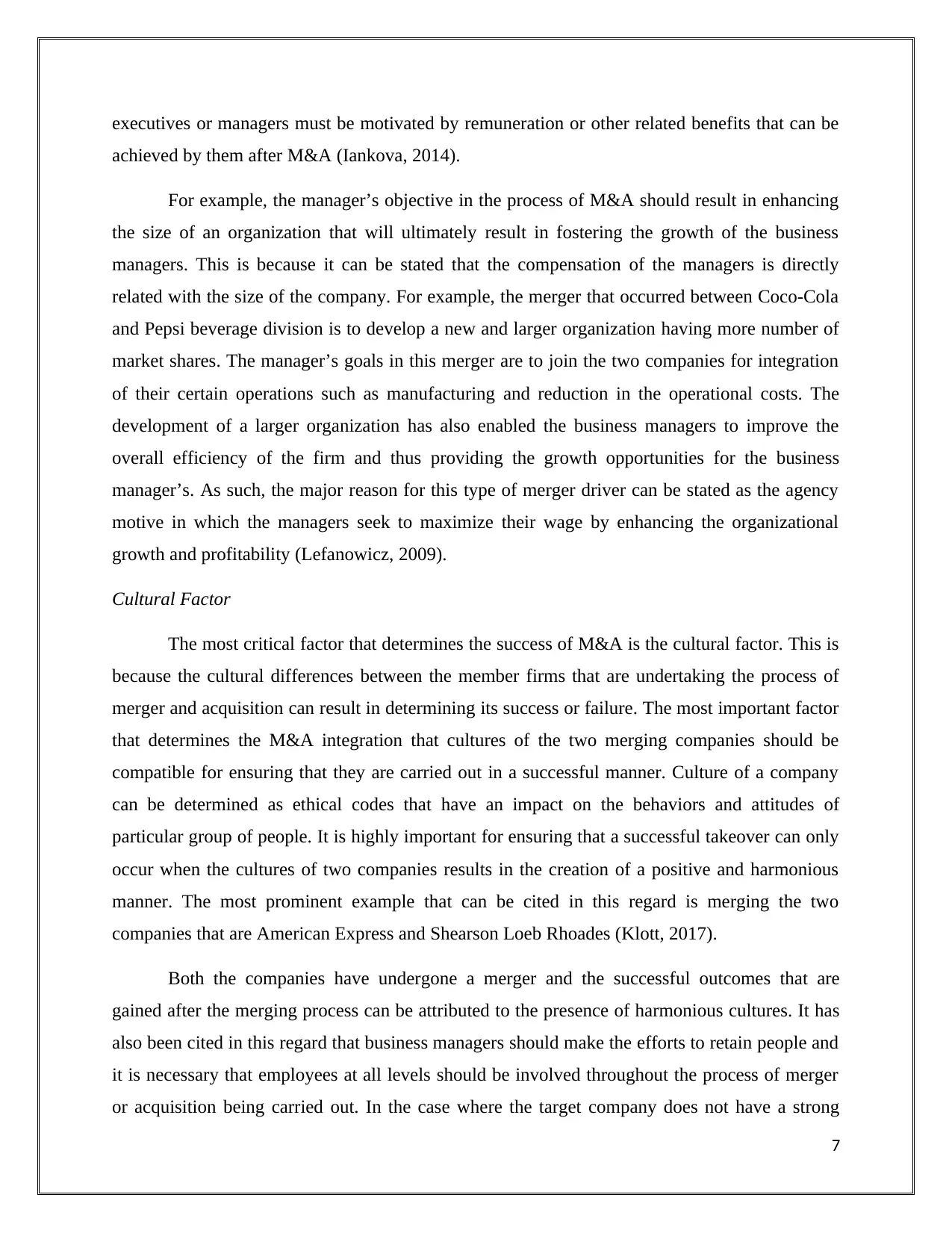
executives or managers must be motivated by remuneration or other related benefits that can be
achieved by them after M&A (Iankova, 2014).
For example, the manager’s objective in the process of M&A should result in enhancing
the size of an organization that will ultimately result in fostering the growth of the business
managers. This is because it can be stated that the compensation of the managers is directly
related with the size of the company. For example, the merger that occurred between Coco-Cola
and Pepsi beverage division is to develop a new and larger organization having more number of
market shares. The manager’s goals in this merger are to join the two companies for integration
of their certain operations such as manufacturing and reduction in the operational costs. The
development of a larger organization has also enabled the business managers to improve the
overall efficiency of the firm and thus providing the growth opportunities for the business
manager’s. As such, the major reason for this type of merger driver can be stated as the agency
motive in which the managers seek to maximize their wage by enhancing the organizational
growth and profitability (Lefanowicz, 2009).
Cultural Factor
The most critical factor that determines the success of M&A is the cultural factor. This is
because the cultural differences between the member firms that are undertaking the process of
merger and acquisition can result in determining its success or failure. The most important factor
that determines the M&A integration that cultures of the two merging companies should be
compatible for ensuring that they are carried out in a successful manner. Culture of a company
can be determined as ethical codes that have an impact on the behaviors and attitudes of
particular group of people. It is highly important for ensuring that a successful takeover can only
occur when the cultures of two companies results in the creation of a positive and harmonious
manner. The most prominent example that can be cited in this regard is merging the two
companies that are American Express and Shearson Loeb Rhoades (Klott, 2017).
Both the companies have undergone a merger and the successful outcomes that are
gained after the merging process can be attributed to the presence of harmonious cultures. It has
also been cited in this regard that business managers should make the efforts to retain people and
it is necessary that employees at all levels should be involved throughout the process of merger
or acquisition being carried out. In the case where the target company does not have a strong
7
achieved by them after M&A (Iankova, 2014).
For example, the manager’s objective in the process of M&A should result in enhancing
the size of an organization that will ultimately result in fostering the growth of the business
managers. This is because it can be stated that the compensation of the managers is directly
related with the size of the company. For example, the merger that occurred between Coco-Cola
and Pepsi beverage division is to develop a new and larger organization having more number of
market shares. The manager’s goals in this merger are to join the two companies for integration
of their certain operations such as manufacturing and reduction in the operational costs. The
development of a larger organization has also enabled the business managers to improve the
overall efficiency of the firm and thus providing the growth opportunities for the business
manager’s. As such, the major reason for this type of merger driver can be stated as the agency
motive in which the managers seek to maximize their wage by enhancing the organizational
growth and profitability (Lefanowicz, 2009).
Cultural Factor
The most critical factor that determines the success of M&A is the cultural factor. This is
because the cultural differences between the member firms that are undertaking the process of
merger and acquisition can result in determining its success or failure. The most important factor
that determines the M&A integration that cultures of the two merging companies should be
compatible for ensuring that they are carried out in a successful manner. Culture of a company
can be determined as ethical codes that have an impact on the behaviors and attitudes of
particular group of people. It is highly important for ensuring that a successful takeover can only
occur when the cultures of two companies results in the creation of a positive and harmonious
manner. The most prominent example that can be cited in this regard is merging the two
companies that are American Express and Shearson Loeb Rhoades (Klott, 2017).
Both the companies have undergone a merger and the successful outcomes that are
gained after the merging process can be attributed to the presence of harmonious cultures. It has
also been cited in this regard that business managers should make the efforts to retain people and
it is necessary that employees at all levels should be involved throughout the process of merger
or acquisition being carried out. In the case where the target company does not have a strong
7
Paraphrase This Document
Need a fresh take? Get an instant paraphrase of this document with our AI Paraphraser
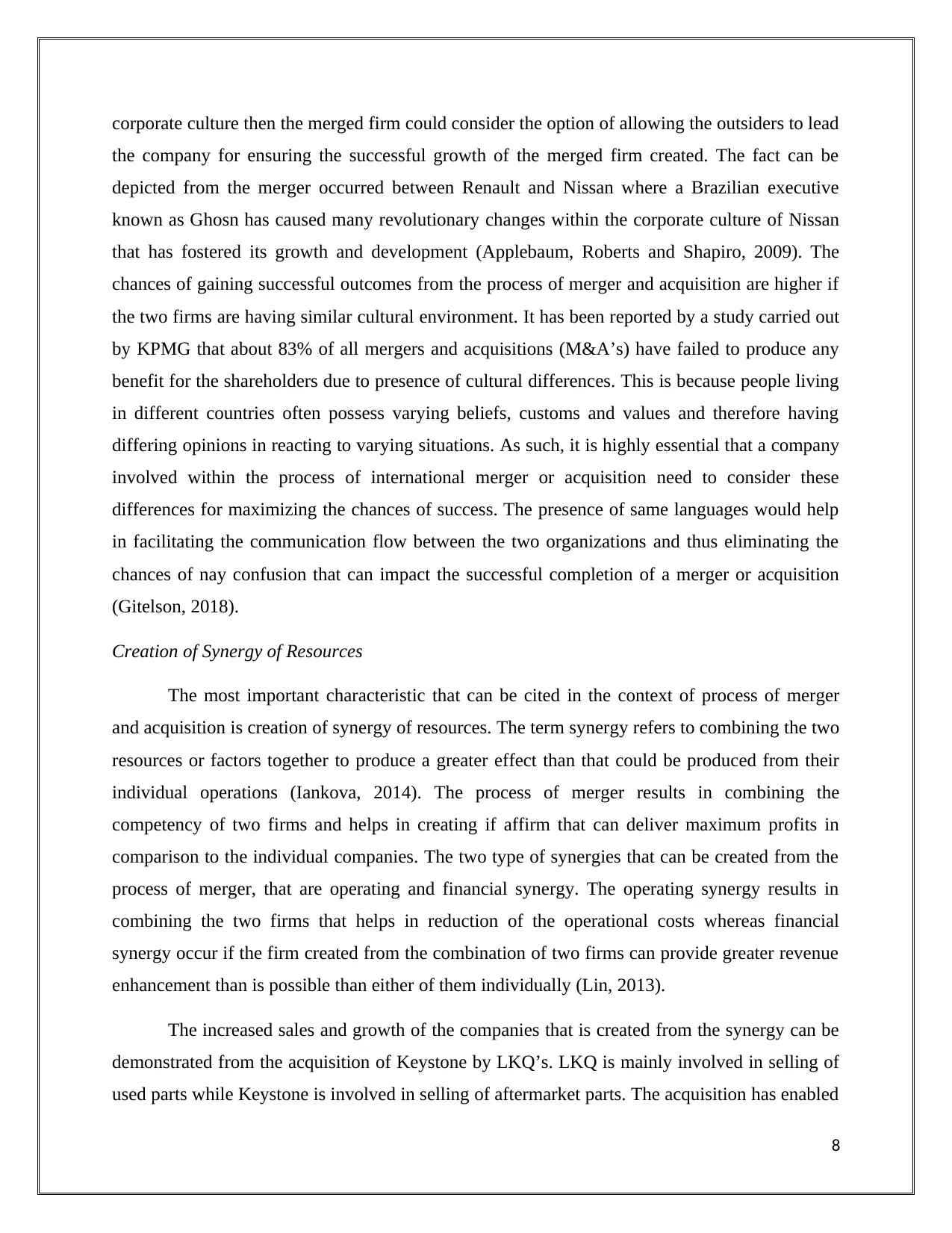
corporate culture then the merged firm could consider the option of allowing the outsiders to lead
the company for ensuring the successful growth of the merged firm created. The fact can be
depicted from the merger occurred between Renault and Nissan where a Brazilian executive
known as Ghosn has caused many revolutionary changes within the corporate culture of Nissan
that has fostered its growth and development (Applebaum, Roberts and Shapiro, 2009). The
chances of gaining successful outcomes from the process of merger and acquisition are higher if
the two firms are having similar cultural environment. It has been reported by a study carried out
by KPMG that about 83% of all mergers and acquisitions (M&A’s) have failed to produce any
benefit for the shareholders due to presence of cultural differences. This is because people living
in different countries often possess varying beliefs, customs and values and therefore having
differing opinions in reacting to varying situations. As such, it is highly essential that a company
involved within the process of international merger or acquisition need to consider these
differences for maximizing the chances of success. The presence of same languages would help
in facilitating the communication flow between the two organizations and thus eliminating the
chances of nay confusion that can impact the successful completion of a merger or acquisition
(Gitelson, 2018).
Creation of Synergy of Resources
The most important characteristic that can be cited in the context of process of merger
and acquisition is creation of synergy of resources. The term synergy refers to combining the two
resources or factors together to produce a greater effect than that could be produced from their
individual operations (Iankova, 2014). The process of merger results in combining the
competency of two firms and helps in creating if affirm that can deliver maximum profits in
comparison to the individual companies. The two type of synergies that can be created from the
process of merger, that are operating and financial synergy. The operating synergy results in
combining the two firms that helps in reduction of the operational costs whereas financial
synergy occur if the firm created from the combination of two firms can provide greater revenue
enhancement than is possible than either of them individually (Lin, 2013).
The increased sales and growth of the companies that is created from the synergy can be
demonstrated from the acquisition of Keystone by LKQ’s. LKQ is mainly involved in selling of
used parts while Keystone is involved in selling of aftermarket parts. The acquisition has enabled
8
the company for ensuring the successful growth of the merged firm created. The fact can be
depicted from the merger occurred between Renault and Nissan where a Brazilian executive
known as Ghosn has caused many revolutionary changes within the corporate culture of Nissan
that has fostered its growth and development (Applebaum, Roberts and Shapiro, 2009). The
chances of gaining successful outcomes from the process of merger and acquisition are higher if
the two firms are having similar cultural environment. It has been reported by a study carried out
by KPMG that about 83% of all mergers and acquisitions (M&A’s) have failed to produce any
benefit for the shareholders due to presence of cultural differences. This is because people living
in different countries often possess varying beliefs, customs and values and therefore having
differing opinions in reacting to varying situations. As such, it is highly essential that a company
involved within the process of international merger or acquisition need to consider these
differences for maximizing the chances of success. The presence of same languages would help
in facilitating the communication flow between the two organizations and thus eliminating the
chances of nay confusion that can impact the successful completion of a merger or acquisition
(Gitelson, 2018).
Creation of Synergy of Resources
The most important characteristic that can be cited in the context of process of merger
and acquisition is creation of synergy of resources. The term synergy refers to combining the two
resources or factors together to produce a greater effect than that could be produced from their
individual operations (Iankova, 2014). The process of merger results in combining the
competency of two firms and helps in creating if affirm that can deliver maximum profits in
comparison to the individual companies. The two type of synergies that can be created from the
process of merger, that are operating and financial synergy. The operating synergy results in
combining the two firms that helps in reduction of the operational costs whereas financial
synergy occur if the firm created from the combination of two firms can provide greater revenue
enhancement than is possible than either of them individually (Lin, 2013).
The increased sales and growth of the companies that is created from the synergy can be
demonstrated from the acquisition of Keystone by LKQ’s. LKQ is mainly involved in selling of
used parts while Keystone is involved in selling of aftermarket parts. The acquisition has enabled
8
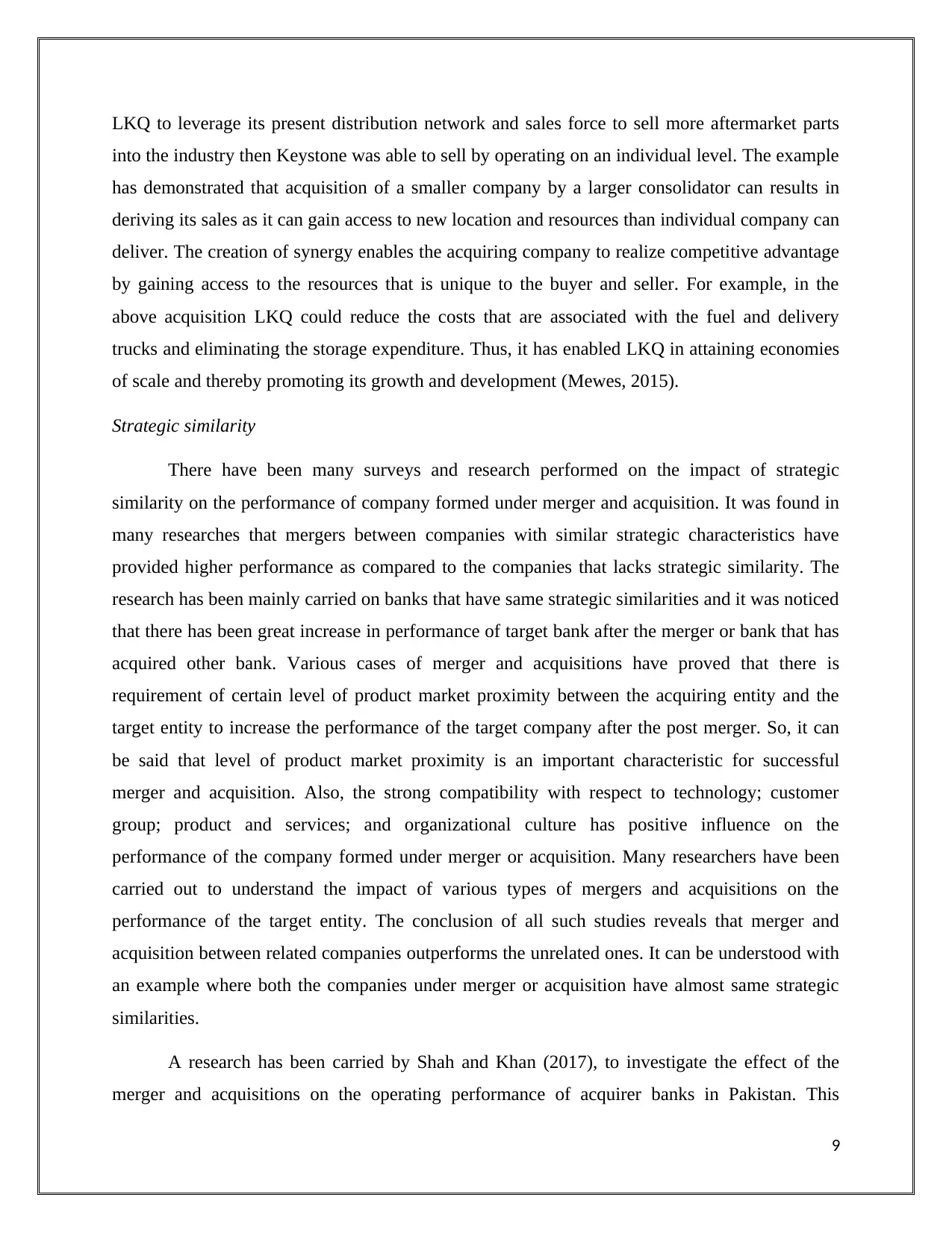
LKQ to leverage its present distribution network and sales force to sell more aftermarket parts
into the industry then Keystone was able to sell by operating on an individual level. The example
has demonstrated that acquisition of a smaller company by a larger consolidator can results in
deriving its sales as it can gain access to new location and resources than individual company can
deliver. The creation of synergy enables the acquiring company to realize competitive advantage
by gaining access to the resources that is unique to the buyer and seller. For example, in the
above acquisition LKQ could reduce the costs that are associated with the fuel and delivery
trucks and eliminating the storage expenditure. Thus, it has enabled LKQ in attaining economies
of scale and thereby promoting its growth and development (Mewes, 2015).
Strategic similarity
There have been many surveys and research performed on the impact of strategic
similarity on the performance of company formed under merger and acquisition. It was found in
many researches that mergers between companies with similar strategic characteristics have
provided higher performance as compared to the companies that lacks strategic similarity. The
research has been mainly carried on banks that have same strategic similarities and it was noticed
that there has been great increase in performance of target bank after the merger or bank that has
acquired other bank. Various cases of merger and acquisitions have proved that there is
requirement of certain level of product market proximity between the acquiring entity and the
target entity to increase the performance of the target company after the post merger. So, it can
be said that level of product market proximity is an important characteristic for successful
merger and acquisition. Also, the strong compatibility with respect to technology; customer
group; product and services; and organizational culture has positive influence on the
performance of the company formed under merger or acquisition. Many researchers have been
carried out to understand the impact of various types of mergers and acquisitions on the
performance of the target entity. The conclusion of all such studies reveals that merger and
acquisition between related companies outperforms the unrelated ones. It can be understood with
an example where both the companies under merger or acquisition have almost same strategic
similarities.
A research has been carried by Shah and Khan (2017), to investigate the effect of the
merger and acquisitions on the operating performance of acquirer banks in Pakistan. This
9
into the industry then Keystone was able to sell by operating on an individual level. The example
has demonstrated that acquisition of a smaller company by a larger consolidator can results in
deriving its sales as it can gain access to new location and resources than individual company can
deliver. The creation of synergy enables the acquiring company to realize competitive advantage
by gaining access to the resources that is unique to the buyer and seller. For example, in the
above acquisition LKQ could reduce the costs that are associated with the fuel and delivery
trucks and eliminating the storage expenditure. Thus, it has enabled LKQ in attaining economies
of scale and thereby promoting its growth and development (Mewes, 2015).
Strategic similarity
There have been many surveys and research performed on the impact of strategic
similarity on the performance of company formed under merger and acquisition. It was found in
many researches that mergers between companies with similar strategic characteristics have
provided higher performance as compared to the companies that lacks strategic similarity. The
research has been mainly carried on banks that have same strategic similarities and it was noticed
that there has been great increase in performance of target bank after the merger or bank that has
acquired other bank. Various cases of merger and acquisitions have proved that there is
requirement of certain level of product market proximity between the acquiring entity and the
target entity to increase the performance of the target company after the post merger. So, it can
be said that level of product market proximity is an important characteristic for successful
merger and acquisition. Also, the strong compatibility with respect to technology; customer
group; product and services; and organizational culture has positive influence on the
performance of the company formed under merger or acquisition. Many researchers have been
carried out to understand the impact of various types of mergers and acquisitions on the
performance of the target entity. The conclusion of all such studies reveals that merger and
acquisition between related companies outperforms the unrelated ones. It can be understood with
an example where both the companies under merger or acquisition have almost same strategic
similarities.
A research has been carried by Shah and Khan (2017), to investigate the effect of the
merger and acquisitions on the operating performance of acquirer banks in Pakistan. This
9
⊘ This is a preview!⊘
Do you want full access?
Subscribe today to unlock all pages.

Trusted by 1+ million students worldwide
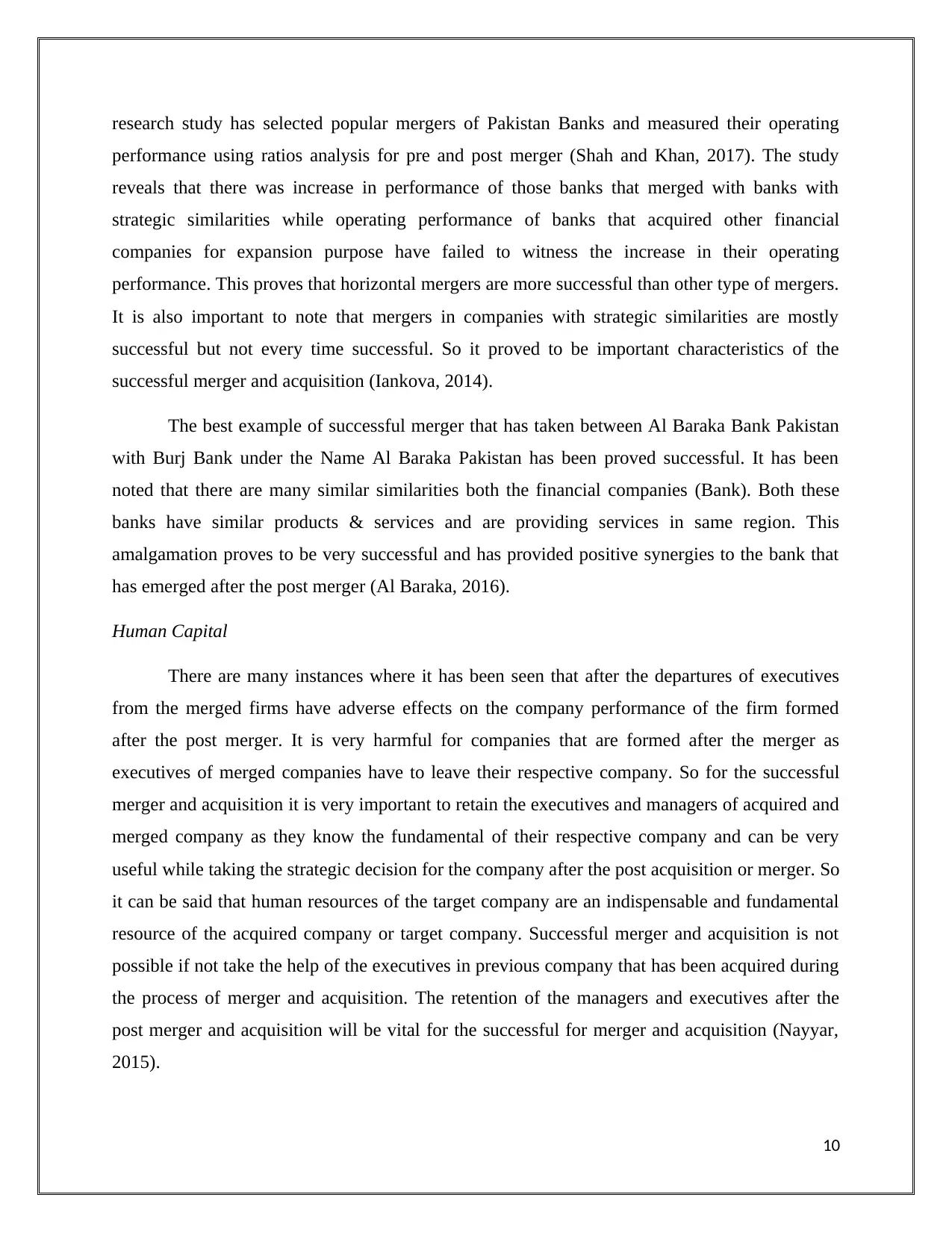
research study has selected popular mergers of Pakistan Banks and measured their operating
performance using ratios analysis for pre and post merger (Shah and Khan, 2017). The study
reveals that there was increase in performance of those banks that merged with banks with
strategic similarities while operating performance of banks that acquired other financial
companies for expansion purpose have failed to witness the increase in their operating
performance. This proves that horizontal mergers are more successful than other type of mergers.
It is also important to note that mergers in companies with strategic similarities are mostly
successful but not every time successful. So it proved to be important characteristics of the
successful merger and acquisition (Iankova, 2014).
The best example of successful merger that has taken between Al Baraka Bank Pakistan
with Burj Bank under the Name Al Baraka Pakistan has been proved successful. It has been
noted that there are many similar similarities both the financial companies (Bank). Both these
banks have similar products & services and are providing services in same region. This
amalgamation proves to be very successful and has provided positive synergies to the bank that
has emerged after the post merger (Al Baraka, 2016).
Human Capital
There are many instances where it has been seen that after the departures of executives
from the merged firms have adverse effects on the company performance of the firm formed
after the post merger. It is very harmful for companies that are formed after the merger as
executives of merged companies have to leave their respective company. So for the successful
merger and acquisition it is very important to retain the executives and managers of acquired and
merged company as they know the fundamental of their respective company and can be very
useful while taking the strategic decision for the company after the post acquisition or merger. So
it can be said that human resources of the target company are an indispensable and fundamental
resource of the acquired company or target company. Successful merger and acquisition is not
possible if not take the help of the executives in previous company that has been acquired during
the process of merger and acquisition. The retention of the managers and executives after the
post merger and acquisition will be vital for the successful for merger and acquisition (Nayyar,
2015).
10
performance using ratios analysis for pre and post merger (Shah and Khan, 2017). The study
reveals that there was increase in performance of those banks that merged with banks with
strategic similarities while operating performance of banks that acquired other financial
companies for expansion purpose have failed to witness the increase in their operating
performance. This proves that horizontal mergers are more successful than other type of mergers.
It is also important to note that mergers in companies with strategic similarities are mostly
successful but not every time successful. So it proved to be important characteristics of the
successful merger and acquisition (Iankova, 2014).
The best example of successful merger that has taken between Al Baraka Bank Pakistan
with Burj Bank under the Name Al Baraka Pakistan has been proved successful. It has been
noted that there are many similar similarities both the financial companies (Bank). Both these
banks have similar products & services and are providing services in same region. This
amalgamation proves to be very successful and has provided positive synergies to the bank that
has emerged after the post merger (Al Baraka, 2016).
Human Capital
There are many instances where it has been seen that after the departures of executives
from the merged firms have adverse effects on the company performance of the firm formed
after the post merger. It is very harmful for companies that are formed after the merger as
executives of merged companies have to leave their respective company. So for the successful
merger and acquisition it is very important to retain the executives and managers of acquired and
merged company as they know the fundamental of their respective company and can be very
useful while taking the strategic decision for the company after the post acquisition or merger. So
it can be said that human resources of the target company are an indispensable and fundamental
resource of the acquired company or target company. Successful merger and acquisition is not
possible if not take the help of the executives in previous company that has been acquired during
the process of merger and acquisition. The retention of the managers and executives after the
post merger and acquisition will be vital for the successful for merger and acquisition (Nayyar,
2015).
10
Paraphrase This Document
Need a fresh take? Get an instant paraphrase of this document with our AI Paraphraser
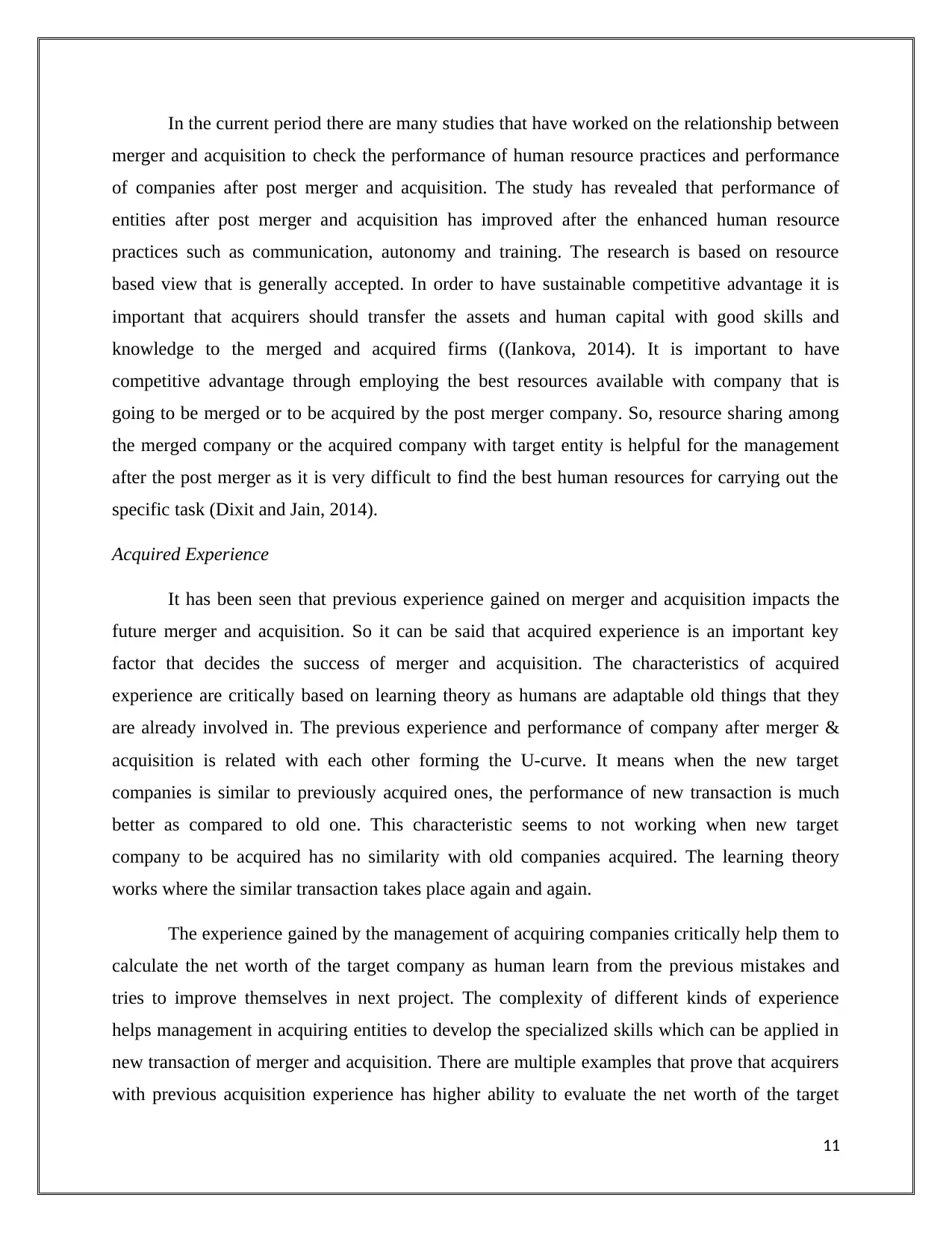
In the current period there are many studies that have worked on the relationship between
merger and acquisition to check the performance of human resource practices and performance
of companies after post merger and acquisition. The study has revealed that performance of
entities after post merger and acquisition has improved after the enhanced human resource
practices such as communication, autonomy and training. The research is based on resource
based view that is generally accepted. In order to have sustainable competitive advantage it is
important that acquirers should transfer the assets and human capital with good skills and
knowledge to the merged and acquired firms ((Iankova, 2014). It is important to have
competitive advantage through employing the best resources available with company that is
going to be merged or to be acquired by the post merger company. So, resource sharing among
the merged company or the acquired company with target entity is helpful for the management
after the post merger as it is very difficult to find the best human resources for carrying out the
specific task (Dixit and Jain, 2014).
Acquired Experience
It has been seen that previous experience gained on merger and acquisition impacts the
future merger and acquisition. So it can be said that acquired experience is an important key
factor that decides the success of merger and acquisition. The characteristics of acquired
experience are critically based on learning theory as humans are adaptable old things that they
are already involved in. The previous experience and performance of company after merger &
acquisition is related with each other forming the U-curve. It means when the new target
companies is similar to previously acquired ones, the performance of new transaction is much
better as compared to old one. This characteristic seems to not working when new target
company to be acquired has no similarity with old companies acquired. The learning theory
works where the similar transaction takes place again and again.
The experience gained by the management of acquiring companies critically help them to
calculate the net worth of the target company as human learn from the previous mistakes and
tries to improve themselves in next project. The complexity of different kinds of experience
helps management in acquiring entities to develop the specialized skills which can be applied in
new transaction of merger and acquisition. There are multiple examples that prove that acquirers
with previous acquisition experience has higher ability to evaluate the net worth of the target
11
merger and acquisition to check the performance of human resource practices and performance
of companies after post merger and acquisition. The study has revealed that performance of
entities after post merger and acquisition has improved after the enhanced human resource
practices such as communication, autonomy and training. The research is based on resource
based view that is generally accepted. In order to have sustainable competitive advantage it is
important that acquirers should transfer the assets and human capital with good skills and
knowledge to the merged and acquired firms ((Iankova, 2014). It is important to have
competitive advantage through employing the best resources available with company that is
going to be merged or to be acquired by the post merger company. So, resource sharing among
the merged company or the acquired company with target entity is helpful for the management
after the post merger as it is very difficult to find the best human resources for carrying out the
specific task (Dixit and Jain, 2014).
Acquired Experience
It has been seen that previous experience gained on merger and acquisition impacts the
future merger and acquisition. So it can be said that acquired experience is an important key
factor that decides the success of merger and acquisition. The characteristics of acquired
experience are critically based on learning theory as humans are adaptable old things that they
are already involved in. The previous experience and performance of company after merger &
acquisition is related with each other forming the U-curve. It means when the new target
companies is similar to previously acquired ones, the performance of new transaction is much
better as compared to old one. This characteristic seems to not working when new target
company to be acquired has no similarity with old companies acquired. The learning theory
works where the similar transaction takes place again and again.
The experience gained by the management of acquiring companies critically help them to
calculate the net worth of the target company as human learn from the previous mistakes and
tries to improve themselves in next project. The complexity of different kinds of experience
helps management in acquiring entities to develop the specialized skills which can be applied in
new transaction of merger and acquisition. There are multiple examples that prove that acquirers
with previous acquisition experience has higher ability to evaluate the net worth of the target
11
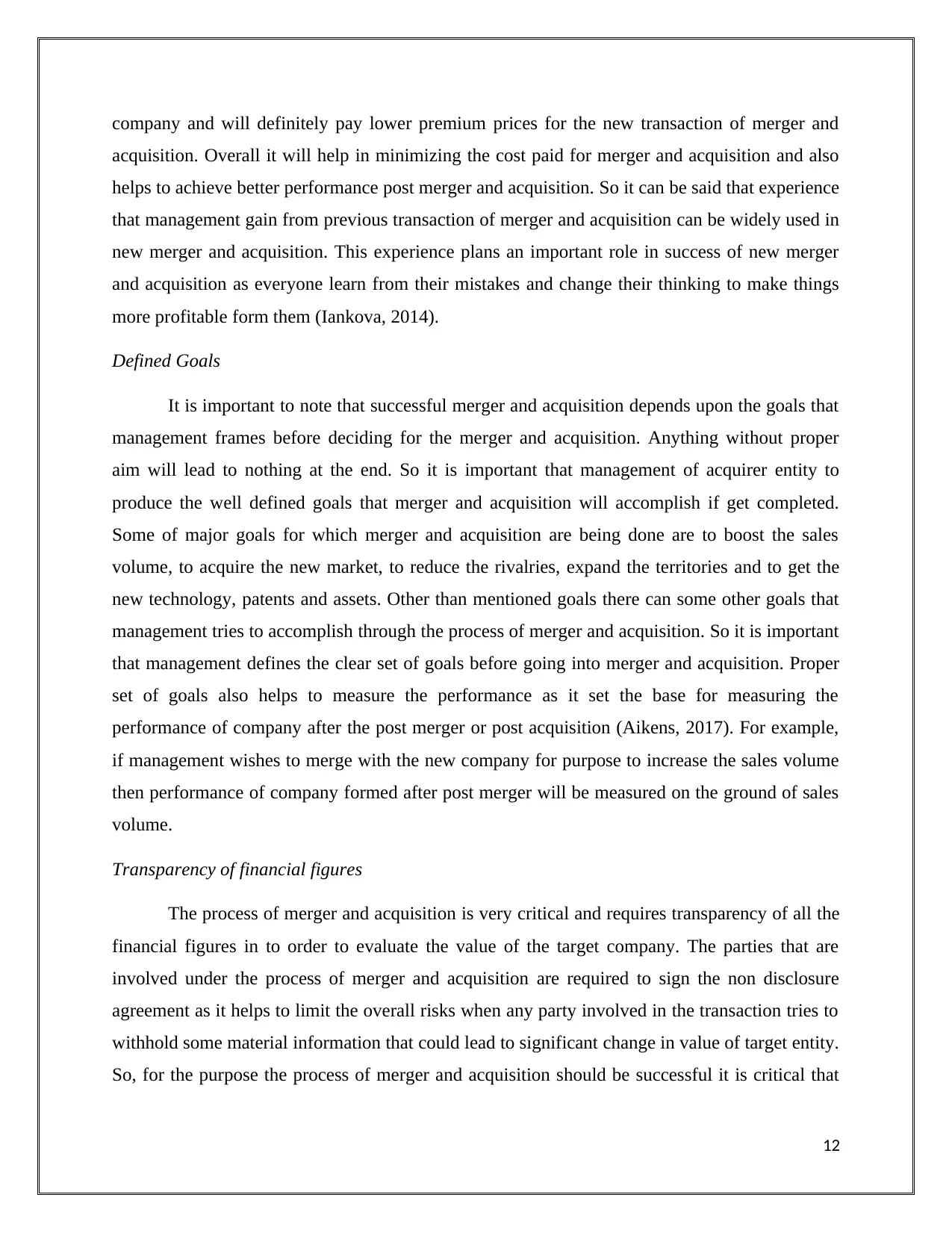
company and will definitely pay lower premium prices for the new transaction of merger and
acquisition. Overall it will help in minimizing the cost paid for merger and acquisition and also
helps to achieve better performance post merger and acquisition. So it can be said that experience
that management gain from previous transaction of merger and acquisition can be widely used in
new merger and acquisition. This experience plans an important role in success of new merger
and acquisition as everyone learn from their mistakes and change their thinking to make things
more profitable form them (Iankova, 2014).
Defined Goals
It is important to note that successful merger and acquisition depends upon the goals that
management frames before deciding for the merger and acquisition. Anything without proper
aim will lead to nothing at the end. So it is important that management of acquirer entity to
produce the well defined goals that merger and acquisition will accomplish if get completed.
Some of major goals for which merger and acquisition are being done are to boost the sales
volume, to acquire the new market, to reduce the rivalries, expand the territories and to get the
new technology, patents and assets. Other than mentioned goals there can some other goals that
management tries to accomplish through the process of merger and acquisition. So it is important
that management defines the clear set of goals before going into merger and acquisition. Proper
set of goals also helps to measure the performance as it set the base for measuring the
performance of company after the post merger or post acquisition (Aikens, 2017). For example,
if management wishes to merge with the new company for purpose to increase the sales volume
then performance of company formed after post merger will be measured on the ground of sales
volume.
Transparency of financial figures
The process of merger and acquisition is very critical and requires transparency of all the
financial figures in to order to evaluate the value of the target company. The parties that are
involved under the process of merger and acquisition are required to sign the non disclosure
agreement as it helps to limit the overall risks when any party involved in the transaction tries to
withhold some material information that could lead to significant change in value of target entity.
So, for the purpose the process of merger and acquisition should be successful it is critical that
12
acquisition. Overall it will help in minimizing the cost paid for merger and acquisition and also
helps to achieve better performance post merger and acquisition. So it can be said that experience
that management gain from previous transaction of merger and acquisition can be widely used in
new merger and acquisition. This experience plans an important role in success of new merger
and acquisition as everyone learn from their mistakes and change their thinking to make things
more profitable form them (Iankova, 2014).
Defined Goals
It is important to note that successful merger and acquisition depends upon the goals that
management frames before deciding for the merger and acquisition. Anything without proper
aim will lead to nothing at the end. So it is important that management of acquirer entity to
produce the well defined goals that merger and acquisition will accomplish if get completed.
Some of major goals for which merger and acquisition are being done are to boost the sales
volume, to acquire the new market, to reduce the rivalries, expand the territories and to get the
new technology, patents and assets. Other than mentioned goals there can some other goals that
management tries to accomplish through the process of merger and acquisition. So it is important
that management defines the clear set of goals before going into merger and acquisition. Proper
set of goals also helps to measure the performance as it set the base for measuring the
performance of company after the post merger or post acquisition (Aikens, 2017). For example,
if management wishes to merge with the new company for purpose to increase the sales volume
then performance of company formed after post merger will be measured on the ground of sales
volume.
Transparency of financial figures
The process of merger and acquisition is very critical and requires transparency of all the
financial figures in to order to evaluate the value of the target company. The parties that are
involved under the process of merger and acquisition are required to sign the non disclosure
agreement as it helps to limit the overall risks when any party involved in the transaction tries to
withhold some material information that could lead to significant change in value of target entity.
So, for the purpose the process of merger and acquisition should be successful it is critical that
12
⊘ This is a preview!⊘
Do you want full access?
Subscribe today to unlock all pages.

Trusted by 1+ million students worldwide
1 out of 23
Related Documents
Your All-in-One AI-Powered Toolkit for Academic Success.
+13062052269
info@desklib.com
Available 24*7 on WhatsApp / Email
![[object Object]](/_next/static/media/star-bottom.7253800d.svg)
Unlock your academic potential
Copyright © 2020–2025 A2Z Services. All Rights Reserved. Developed and managed by ZUCOL.




